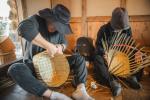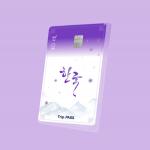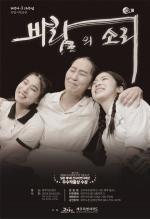- Shamanistic rite at the heart of winter adapts agrarian traditions for modern life
 |
||
| ▲ A prostrate shaman pays his respects at last year’s festival Photo The Jeju Weekly DB | ||
“Daehan,” the coldest period in the lunisolar calendar, has just passed. Soon after “Shingugan,” Jeju’s traditional moving season, the island’s 18,000 gods are back on earth to begin their duties, having had new posts assigned by the Great Jade Emperor.
Take heart in the dead of the winter, however, as “Ipchun” signals the onset of spring at the head of the lunisolar calendar. On Jeju, preparation for the “Tamnaguk Ipchun Gutnori,” is in full swing to celebrate the event. This year’s festival, in its 15th year, will be held between Feb. 2-4.
Tamnaguk Ipchun Gutnori is the traditional festival marking the “Gut” - shamanistic ceremony - passed down from the Tamna kingdom between the 7th and 12th centuries. The festival was originally “Pungnong Gut,” a ritual for an abundant harvest, but this died out in 1925 during the Japanese occupation.
It was revived in 1999 with the inception of the Tamnaguk Ipchun Gutnori festival, and is now an annual event. As society modernizes, the original agrarian meaning has faded, and people now ask the gods for well-being and prosperity for the year ahead.
Tamnaguk Ipchun Gutnori is the first such rite of spring held in Korea each year, pushing warm energy from the southern end of the country northerly over the peninsula.
This traditional festival is an event to witness both the cultural distinctiveness and diversity of Jeju. Not only is Tamna-guk Ipchun Gutnori a unique festival to celebrate the coming of spring, but it also highlights the shared culture of Korea, China and Japan; in agrarian societies, spring is important as it signifies the beginning of the farming season.
Although the way people do so is different, both Chinese and Japanese celebrate this day. In China it is observed on Feb. 5 and is known as “Da chun,” when people whip an earthen ox figure. Japanese people celebrate “Setsubun” by throwing roasted beans inside and outside of the house to cast evil away and bring good luck.
Jeju’s tradition is distinct from the Korean mainland, as there the first full moon, Jeongwol Daeboreum, is marked by the Pungnong Gut; Ipchun, however, is usually marked earlier than this.
Thanks to preservation efforts, Tamna-guk Ipchun Gutnori is now held annually and Jeju people can maintain this traditional celebration. This makes the event distinct from mainland Korea, as there all that remains of the day is the affixing of a handwritten poster, “Ipchun-daegil,” to the main gate of the house to bring luck.
In Jeju, Tamnaguk Ipchun Gutnori is an authentic - if revived - traditional festival, where the rituals of Jeju shamanism, being the epitome of traditional culture, are central themes. There are many so-called traditional festivals on Jeju which were actually created during the 1960s modernization period. For example: Seong-eup Jeonguigol Festival, a folk ritual of harvesting straw and burial ground stamping; Deoksu-ri Traditional Folk Festival, featuring traditional ironware making; and Tamna Cultural Festival, a kind of folk arts contest.
Compared to these, despite nearly 80 years of rupture, Tamnaguk Ipchun Gutnori is a bona fide and deep-rooted traditional festival on the island.
Therefore, it can be said that the traditional festival of Tamnaguk Ipchun Gutnori has contributed to cultural preservation by celebrating the cultural identity of the Jeju people. It also raises public awareness of the traditions of Jeju shamanism and enables performers and audience members to share - as well as to learn - the significance of traditional culture.
For similar reasons, people emphasize the potential of the festival to represent ‘true’ Jeju tradition. For that, however, it must connect with other related traditions, such as Shingugan and village shrine rituals, while also encouraging people to voluntarily participate and share authentic meanings.
Despite it being a traditional festival, Tamnaguk Ipchun Gutnori continues to evolve. Last year, the agriculture goddess, Jacheongbi, depicted on a giant traditional-style lamp, shone over the people gathered for the festival.
Anticipation mounts each year; at Tamnaguk Ipchun Gutnori, enjoy the rite of spring.
Hong Sun Young is a PhD candidate researching cultural preservation and the traditions of Jeju Island.
Hong Sun Young contributor@jejuweekly.com
<저작권자 © 제주위클리 무단전재 및 재배포금지>






